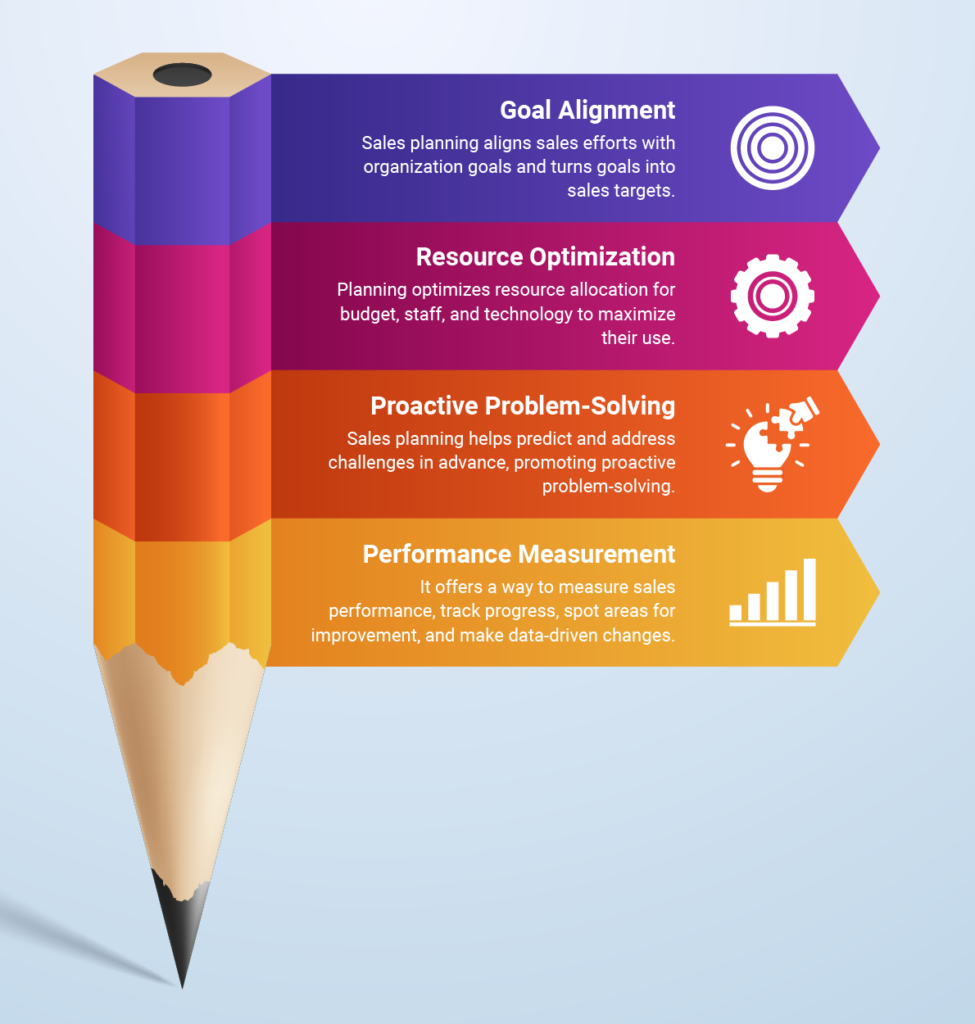In the ever-evolving world of sales, having a well-structured strategy is paramount. Whether you are a seasoned sales professional or just starting your career, a comprehensive sales strategy can make all the difference in reaching and exceeding your targets.
In this guide, we will delve into the essential components of a successful sales strategy. We will provide templates and illustrative examples to help you craft your own.
Understanding the Sales Strategy
Before we dive into the templates and examples, let’s establish a solid understanding of what a sales strategy entails. At its core, a sales strategy is a well-thought-out plan that outlines the approach a company or individual will take to achieve their sales goals.
The sales strategy encompasses everything from identifying target customers and setting sales targets to choosing the right sales channels and crafting compelling messaging.
The Importance of Sales Planning
Sales planning is not just a routine task; it’s a strategic imperative for any business. It serves as the roadmap that guides your sales team toward achieving targets and milestones. Here’s why sales planning is crucial:

Components of an Effective Sales Strategy
A robust sales strategy encompasses several pivotal components, each contributing to a well-structured plan designed for success. Here, we provide a detailed breakdown of the first key element:
1. Define Your Objectives
At the heart of every highly effective sales strategy lies a crystal-clear set of objectives. These objectives serve as the guiding stars, directing your sales efforts toward specific, attainable goals.
When defining your objectives, it’s imperative to be as precise as possible, adhering to the SMART criteria—Specific, Measurable, Achievable, Relevant, and Time-bound. Let us delve deeper into this essential component:
Template
Objective: Begin by articulating your primary sales objective. What is it that you aim to achieve through your sales endeavors? This should be concise and unambiguous, leaving no room for ambiguity.
Key Results: Next, outline the specific metrics or outcomes that will help you gauge your progress and ultimate success in achieving your objective. These key results provide the quantifiable benchmarks against which you can measure your performance.
Timeline: Specify the timeframe within which you intend to realize these objectives. This temporal aspect adds a critical dimension to your goal-setting, ensuring a sense of urgency and alignment with your broader business strategies.
Illustrative Example
Objective: Achieve a 20% increase in quarterly sales revenue over the next six months.
Key Results:
- Achieve $500,000 in new sales contracts.
- Increase average order value by 15%.
- Expand the customer base by 10%.
Timeline: “From the first quarter Q1 to the second quarter Q2 of the current fiscal year.”
In this example, the objective is defined with utmost clarity, aiming for a substantial revenue boost within a specified timeframe. The key results, quantified and measurable, encompass the financial targets and growth indicators. The timeline sets a clear deadline, adding urgency to the objective.
With this level of precision and structure in defining your objectives, you lay a solid foundation for the subsequent steps of your sales strategy, ensuring that your efforts are not just purposeful but also focused on tangible outcomes.
2. Identify Your Target Audience
Understanding your target audience is at the core of a successful sales strategy. It’s imperative to gain comprehensive insights into who your ideal customers are to effectively tailor your sales efforts. Here, we break down this crucial step:
Template
Buyer Persona: Begin by creating distinct buyer personas, each representing a specific segment of your target audience. A buyer persona typically includes a name and a brief description that humanizes your ideal customer.
Demographics: Dive into the demographic details of your target audience, encompassing factors such as age, gender, location, and more. These details provide a foundational understanding of your customers’ characteristics.
Pain Points: Recognize the difficulties or issues encountered by your target audience. Understanding their pain points allows you to position your product or service as a solution to their specific needs.
Motivations: Delve into what drives your customers’ purchasing decisions. What are their aspirations, desires, or goals that your offering can fulfill?
Buyer’s Journey Stage: Determine where your target audience stands in their buyer’s journey—whether they are in the awareness, consideration, or decision stage of making a purchase.
Illustrative Example
Buyer Persona: Marketing Manager Mary
Demographics:
- Age: 35-45
- Location: New York City
- Gender: Female
Pain Points:
- Struggling to increase online lead generation.
- Overwhelmed with managing multiple marketing channels.
Motivations:
- Seeking efficient marketing automation solutions.
- Interested in proven ROI strategies.
Buyer’s Journey Stage: Consideration
In this illustrative example, Marketing Manager Mary is vividly portrayed, complete with her demographics, pain points, motivations, and current position in the buyer’s journey. This level of detail enables a more precise and personalized approach to sales efforts, ensuring that Mary’s specific needs and challenges are addressed effectively.
By crafting such detailed buyer personas, you equip yourself with a nuanced understanding of your target audience, allowing you to tailor your sales strategy to resonate with their unique characteristics and preferences. This, in turn, enhances your ability to engage, convert, and retain customers successfully.
3. Choose the Right Sales Channels
Opting for the most effective sales channels to reach your target audience is a pivotal decision in your sales strategy. Here, we provide a comprehensive expansion of this crucial step:
Template
Sales Channels: Enumerate the specific sales channels you intend to utilize as part of your sales strategy. These channels can encompass a mix of both online and offline methods.
Rationale: Elaborate on the reasoning behind your selection of these channels, explaining why they are particularly suitable for engaging with and reaching your target audience effectively.
Illustrative Example
Sales Channels:
- LinkedIn for B2B Lead Generation. LinkedIn has proven to be an invaluable platform for connecting with professionals within our industry. Its robust networking capabilities and business-focused environment make it an ideal channel for generating B2B leads.
- Email Marketing for Nurturing Leads. Email marketing stands out as a versatile and highly personalized means of communication. It allows us to nurture leads, provide relevant content, and maintain a direct line of contact with potential customers.
- Attend Industry-Specific Trade Shows. Industry-specific trade shows offer a unique opportunity for face-to-face interactions with potential clients. These events allow us to showcase our offerings and build valuable relationships within our niche market.
Rationale:
- LinkedIn. As our target audience comprises professionals in our industry, LinkedIn provides a platform where we can connect directly with decision-makers and engage in meaningful B2B conversations.
- Email Marketing. The versatility of email marketing enables us to deliver tailored content, addressing the specific pain points and interests of our leads. Trust is built through this personalized approach.
- Trade Shows. Attending industry-specific trade shows aligns with our strategy to establish a physical presence and engage in in-depth conversations with potential clients. It’s an effective way to showcase our products and services.
In this example, we have outlined three distinct sales channels and provided a rationale for each. The reasoning behind the choices is based on their suitability for reaching the target audience effectively.
This level of detail in channel selection ensures that your sales efforts are focused on avenues that are not only relevant but also aligned with your audience’s preferences and behavior.
By choosing the right sales channels, you position your sales strategy for success, as it enables you to connect with your target audience through the channels they frequent and prefer.
4. Develop Sales Forecast
Crafting compelling and tailored messaging for every stage of the sales funnel is the cornerstone of an effective sales strategy. Here, we provide an in-depth exploration of this crucial step:
Template
Sales forecast: Begin by articulating your core message. This message should succinctly convey the value and benefits of your product or service.
Pain Points Addressed: Specify the precise challenges or pain points that your target audience encounters. This step ensures that your messaging directly addresses the issues your potential customers face.
Unique Selling Proposition (USP): Highlight what sets your offering apart from the competition. Your USP encapsulates the unique advantages and features that make your product or service a compelling choice.
Call to Action (CTA): Prompt the desired action that you want your audience to take. A clear and persuasive CTA guides your potential customers toward the next steps in the sales process.
Illustrative Example
Sales projection: “Boost Your Team’s Efficiency with Our Cutting-edge Project Management Solution.”
Pain Points Addressed:
- Overwhelmed with disorganized task management.
- Frustration due to missed deadlines and inefficient collaboration.
Unique Selling Proposition (USP): “Our platform integrates seamlessly with your workflow, ensuring every task is tracked, and teams collaborate more effectively.”
Call to Action (CTA): “Sign up for a free trial and experience a transformation in your project management.”
In this example, the sales message distinctly presents the advantages of the project management platform. It tackles the challenges potential clients might face, such as disorganized tasks and inefficient teamwork.
The USP underlines the product’s integration capabilities and its focus on collaboration, differentiating it from other platforms. The CTA pushes for immediate engagement by offering a free trial, giving prospects a chance to experience the benefits firsthand.
By meticulously developing your sales forecast, you ensure that your communication resonates with your target audience at each stage of the sales funnel. This tailored approach demonstrates a deep understanding of your customers’ needs and positions your product or service as the ideal solution, ultimately driving conversions and sales success.
Putting It All Together
Strategic sales planning is a dynamic process that requires constant evaluation and adjustment. The templates and illustrative case studies provided here serve as a valuable starting point for creating your own sales plan.
Remember, a well-executed sales plan can be the key to achieving your revenue targets and propelling your business toward success. With clear objectives, targeted strategies, and a dedicated sales team, you’re well on your way to crafting a winning sales strategy.

